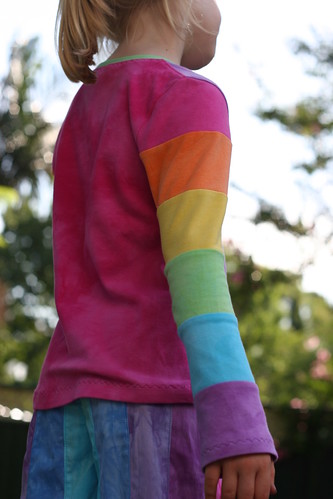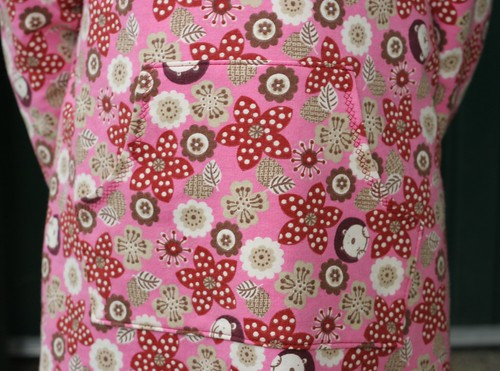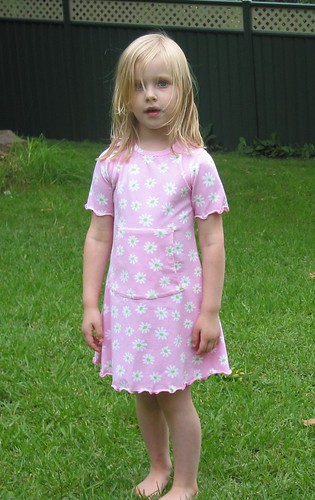Sara is from Willow & Moo, and has been sewing with knit for years, and has kindly shared some thoughts about sewing with knit to help us all.
Thank you Sara!
Something in knit is February's challenge. Carolyn has asked me to write a bit about sewing with knits. I am by no means an expert, but I sew a lot of knits, mostly cotton and cotton/spandex. I was afraid of them before I started. I'd heard all the horror stories, but I wasn't going to let that stop me. I did my usual thing of doing a bit of research before embarking upon a project. It's my scientific training. Following are links and bits of information that I've found useful.
Knits always seem a bit scary for the uninitiated, but they are quite forgiving.
Here are two great links with lots of excellent information about knits.
Timmel Fabrics Sewing with Knits Lessons
Denver Fabrics - sewing with knits
With knits choosing the right needle is important. I use either a ballpoint needle or a stretch needle. A sharp needle can pierce the fibres on a knit and make holes. A ballpoint needle will push through the fibres without damaging them. I sew a lot a knits with spandex, and I use a stretch needle on those.
Use polyester thread. I will admit that I do use cotton thread at times, but that is because I am a dyer and need my thread to dye with the garment. Polyester thread has more give in it, so it's less likely to break if stretched. Wooly nylon can also be good to use in the lower looper of your overlocker.
If you have an overlocker, use it. It's quick easy and gives you a seam that can handle the stretching of the fabric. If you don't have an overlocker, you can still sew knits. I use my sewing machine for some things when sewing knits like topstitching or when I need the sort of control that I can't get with the overlocker. If I use my sewing machine, I use my walking foot. A walking foot isn't just for quilting. It walks the fabric through the machine. This keeps it from getting stretched out. If for some reason I want to use a different foot on my machine then I lower the presser foot pressure. Not all machines can do this though.
If you are sewing a seam with a sewing machine, you can use your machine's stretch stitch. You can also use a wobble stitch - a regular stitch length (2.5-3.5 whatever you like) and a 0.5 zigzag. I also reduce my tension a little. Reducing the tension provides a bit more give in the stitches.
After reading the draft of this Carolyn said to me, but how do you deal with curling edges? And my reply is that I just deal with them. It's jersey knits that have a tendency to curl on the edges and this can make it difficult to line up the edges of the fabric. To be honest it drove me mad when I first started sewing knits, but now I don't even think about it. If I am trying to match stripes, I either use some pins (and more pins) or Wash-a-way Wonder Tape. Some other things that you can try to tame curling edges are starching and pressing the edges or you can use a gluestick. I've read about people using washable glue stick to stick the edges together. You need to let the glue dry before sewing!
After you sew a seam or hem, steam is your friend. Even if the seam appears a bit wavy a quick press with steam will usually bring it back into shape.
Now if you haven't done a neckline, it can seem scary. There are two main ways in which you can finish the neck. One is with a rib style band, and the other is to bind the neck. Lesson 2 on the Timmel Fabrics site shows you how to do both types. I found this link invaluable. Here is another great tutorial for a bound neckline. The one thing to always remember that the length of fabric that you use for the ribbing or binding will depend on the stretch of the fabric. With experience it becomes easier to know how much to use.
There are several options for hemming knits.
1.Coverstitch machine – this produces a hem like you find on a store bought shirt. It's two rows of stitches with a sort of zig zag on the back which covers the edge of the hem.
2.A twin needle – a twin needle can be used to give the same effect as a coverstitch on a sewing machine. You need a stretch twin needle and a common width for hems is 5mm, but if you like a narrower gap between the stitching, look for a 3mm.
3.A stretchy decorative stitch on your sewing machine. I do this a lot. For girls' items I use something that looks like a curvy or wavy stitch.
For boys' items I sometimes use a honeycomb stitch.
The honeycomb stitch is on the pocket openings.
4. Lettuce hem
I do my lettuce hems by setting up my overlocker for a 3-thread rolled hem. Then I stretch the fabric as I sew it. This creates the lettuce effect. Not all knits lettuce well. The very first time I tried it. I thought that I was doing it wrong. Turned out the knit I was using just didn't lettuce. So before you get your heart set on using a lettuce hem, test it out on a scrap of fabric.
I use Steam-a-seam 2 on my knit hems. It's stabilises and holds my hem without pins, so it's easy and quick to stitch. Even though Steam a Seam is a fusible, it still has some stretch and give to it. There is also another method of hemming knits using Solvy (If you haven't visited Pam's blog before, have a look around. She's an inspirational seamstress).
Do you have a pattern already? Or do you need a suggestion? Kwik Sew makes lots of knit patterns as do Jalie. If you are looking for great fashionable tops, Ottobre Design always has fabulous t-shirt patterns in their magazines. They also have a stand alone basic t-shirt pattern, Ottobre 301 for kids and 303 for women. The first knit pattern that I ever made was the underdress of the Farbenmix Olivia pattern. It is still one of my favourite patterns as it is quick and simple to put together and the end result is fantastic.
addit: there is some project ideas in amoungst the commnets ;)








13 comments:
Great post, thank you so much Sara and Carolyn.
Not an expert Sara - I beg to differ:) I will sew a shirt - if I keep telling myself it WILL HAPPEN:)
thats a great help thanks Sara! I've just got an overlocker for christmas and wanted to do a lettuce hem but it didn't really say how, I'll try your tips and definitely check out those links :)
I still don't know what to make for my Feb project but will have fun finding something.
Wow - Sara (via Carolyn) this is a great post. So much information!!! Brilliant. I didn't realise just how much I had to learn... looks like February is going to be another learning month for me.
Any ideas for a good starter project?
Thanks Sara. Great post. Maybe I should look at some of those links. I don't think being self taught menas that I am doing things right or the best that I could be doing!
So much information! Thanks!
wow thanks Sara - thats exceptionally valuable.
Thanks for a really informative and interesting post. I have sewn with stretch before but only simple shapes - I'm excited to try something a little more challenging this month!
Wow Sara you are not an expert you are a Stretch Godess!!
Just reading this I learned things - and that's without checkig out all the links!
OK - I think I am in for this one Carolyn....
Thanks for all the info and great links too!
Sally, if you have a girl a Farbenmix Olivia dress is a great starter project IMO. You can avoid doing a neck binding/ribbing because of the hood! LOL I think a t-shirt is a great project too. I am biased because I am a plus-size mama, so it's very difficult to find nice t-shirts. They usually fit like sacks. I've found it's so easy for me to make nice fitting tees. I love wearing them!
Thanks for the compliments everyone.
Thanks Carolyn! :)
Oh pyjamas make a great project too for a first timer. Even if they aren't perfect, they are still useful!
For children, I know Ottobre recently had some PJ patterns. I've used Kwik Sew 3234 quite a bit.
Great tips from a knit pro! Love the new look Carolyn.
Post a Comment